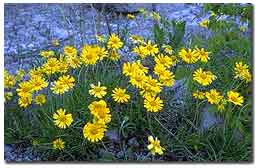![]()
 |
Lakeside Daisies, found in a few sites near the Great Lakes, has declined in recent years because limestone quarrying destroys it's habitat. |
|
The percentage of the world's plants
threatened with extinction is much larger than commonly believed and could
be as high as 47 percent if tropical species are included, researchers said.
The study, published in the journal Science, challenges earlier research
that estimated the number of species in danger of extinction was about 13
percent.
Previous studies of extinct plants underestimated the numbers because they failed to include many plants growing in tropical countries such as Ecuador and Colombia. Plants are becoming extinct for many reasons, including global warming and human encroachment into area habitats, said Peter Jorgensen, a researcher at the Missouri Botanical Gardens in St. Louis who coauthored the new study. For example, scientists discovered a single collection of the passion flower, a light purple flower found only in southern Ecuador, during the 1970s, Jorgensen said. However, recent trips to the region have found the species has since disappeared. Jorgensen reviewed data from 189 countries and territories and determined that between 310,000 and 422,000 plants -- or 22 to 47 percent -- could be threatened. In previous studies "if you can't evaluate a species you basically don't include it," Jorgensen said in a telephone interview. "Still, we don't know enough ... to go out and do something active on the ground to save them," he said. "Just because there are more of them doesn't mean it's easier." Identifying threatened species is a crucial step toward developing better management plans to protect them, but Jorgensen conceded it will take a large amount of money to develop such projects. Maintaining a global database of threatened plants would cost an estimated $12.1 million annually, the researchers said. The vast majority of plants that are threatened in tropical areas are those located with a wide variety of plant life or where habitat loss is rapidly occurring. As a model for their research, Jorgensen and his coauthor, Nigel Pitman from Duke University, analyzed more than 4,000 species that are native to Ecuador. After sifting through data and determining those that could be on the verge of extinction -- such as plants with small populations or which are located only in a small geographical area -- they determined that 83 percent of all plants in the country are threatened. The findings for Ecuador are important, Jorgensen said, because the country has one of the most complete databases of plant species. Such results also can be applied to neighboring countries such as Peru and Colombia where data are scarce. "We know so little about plants in tropical regions," said Jorgensen. "And what really bothers me is we have to guess so much because we don't have enough manpower to go through all the countries." |
|
![]()